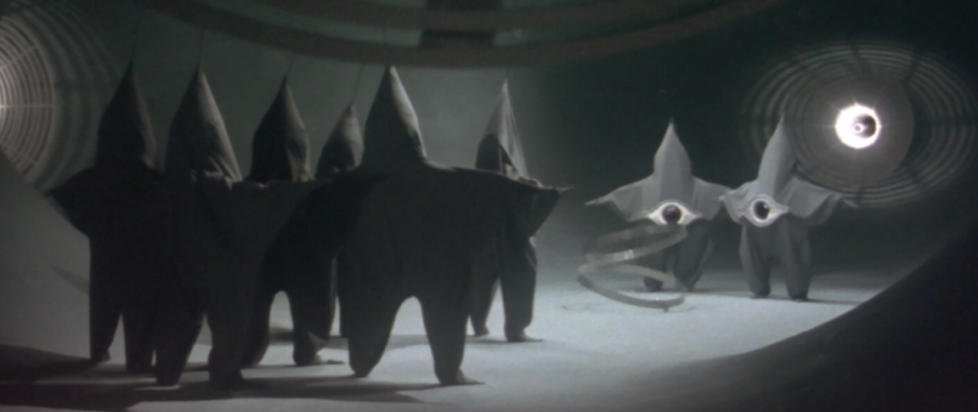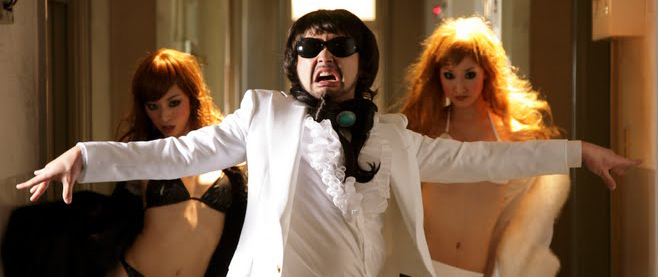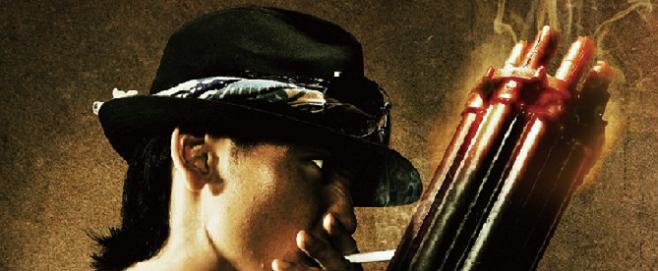
Nearing the End of the World: Warning from Space (1956)
My TV inexplicably gets a channel that just shows Rifftrax all day. This is how I happen to know that there’s a Rifftrax of Warning from Space, even though I’ve never watched it. That this may color your expectations of Warning from Space should come with a grain of salt, since I happen to know that there’s also a Rifftrax of genuine classics like Night of the Living Dead on there.
The first Japanese sci-fi movie filmed in color, Warning from Space – which was released in its native land under the title Spacemen Appear in Tokyo – is (in)famous for its weird, starfish aliens designed by avant-garde artist Taro Okamoto. Similar creatures apparently show up in the (probably much worse) 1966 movie Evil Brain from Outer Space, which also features this guy, and the aliens in Warning from Space actually look uncannily like the DC Comics villain Starro, who wouldn’t appear for another four years.
While the aliens are the stars of the show (pun intended), however, they’re actually not in it much. In fact, for Japan’s first color sci-fi movie, there’s not a ton of sci-fi in this familiar tale of friendly extraterrestrials come to warn humanity that earth is about to collide with another planet.
Instead, we get heaping helpings of regular folks going about their lives – including frequent pastoral sequences, in case you had forgotten why earth getting wiped out by a rogue planet was a bad thing – and lots of shots of people looking concerned while peering through telescopes. If the point needs driven home further, the kids in the movie are continuously singing a song about their “lovely town” and “how delightful everything is.”
What the picture does make good use of is its color photography as, despite the Disney nature show equivalent of a naturalistic palette throughout, the scenes redden and darken as the oncoming planet draws nearer. In fact, the sequences of the planet’s approach are genuinely harrowing at times, as the city scrambles to evacuate – where to is unclear – leaving behind empty city streets and goldfish who boil alive in their bowls. It’s all a jarring counterpoint to the idyllic vignettes that make up much of the rest of the film.
So, is Warning from Space a genuine classic like Night of the Living Dead? Not nearly. But it’s closer to that than to what you might expect from a Rifftrax feature, even if much of the picture doesn’t make a ton of sense. (What exactly is the plan of the guy who claims that he was “born in Heaven” and who is trying to get the incredibly destructive formula from the professor by … tying him to a chair and leaving him for days? Why do the aliens take human form to infiltrate our society in order to pass along the eponymous warning, only to then not bother to do so and instead spend time playing tennis?)
It probably doesn’t help at all that the version playing on Rifftrax is likely the English-language dub which was shown on American TV and which reorganized the order of the picture, opening with the sequence of the starfish aliens that, in the original, doesn’t crop up until the middle of the film. Not that I have ever seen this dub version, either, but the booklet that accompanies the new Arrow Blu-ray goes into its production in vivid detail.
In fact, the two essays that accompany this new release of Warning from Space are given over entirely to the English-language dub version (not available on the Blu) and Taro Okamoto’s alien designs, even though there’s plenty more to talk about. But those two subjects do underscore the two very different ways to approach Warning from Space.
Many people who have seen the film before – or who are doing so for the first time on this new Arrow Video Blu – probably did so purely for camp value, lured in by the unmistakable shots of the starfish aliens in their pajama-like body suits. Those watching Warning from Space for camp, however, were probably sorely disappointed as, outside the starfish aliens themselves and a jokey tennis match, there’s not much camp to be had.
The film is, instead, an earnest and slow-paced fable about nuclear disarmament, made by people who seemed to genuinely find the subject worth talking about, even if they had to use aliens to do it. When the aliens are detailing their plan to convince all the nations of earth to fire their entire nuclear payload at the rogue planet all at once, they explain that they came to Japan first because it was the only nation that had experienced “the horror of nuclear war.”
The script is adapted from a Gentaro Nakajima novel by frequent Kurosawa collaborator Hideo Oguni, whose other feature credits include Seven Samurai, Ran, Ikiru, and others. As such, it is less interested in sci-fi spectacle than the misleading ads, which showed the starfish aliens towering over buildings (they’re actually only about the size of a person) or promised a “seductive android woman.”
Instead, Warning from Space spends 90% of its running time watching people waiting for things. If that sounds boring, well, sometimes it is, but in a movie about the possible end of the world it can also be effective.
Even the aliens, the obvious camp element of the film, are easier to swallow than one might expect. Despite the visible wires that help hold them up, their cumbersome awkwardness never quite seems like it is intended to be read as realistic. At odds with the prosaic nature of the rest of the film, the aliens seem intentionally surreal, a fact supported by a translated quote from their creator in the Arrow Video booklet: “Humanity exists in the rupture between reality and abstraction.”
After all, Taro Okamoto had worked with artists like Pablo Picasso and surrealist leader Andre Breton, and he was a believer in the film’s anti-war disarmament message. His most famous work is the massive mural Myth of Tomorrow, which currently resides in Shibuya station in Tokyo and which is a direct confrontation of the horrors of nuclear war, the “myth” of the title being “the tomorrow that didn’t arrive for those who lived in Hiroshima and Nagasaki,” as artist Nick West writes in an essay in the Arrow booklet.
At times, the script itself seems to be in on the gag of the aliens’ outlandish appearance. When they wonder aloud – their language a series of weird aquatic whoops accompanied by a flashing of their central eye – whether they look hideous to earthlings, they are shown a picture of actress Toyomi Karita, as the celebrity whom they will ultimately impersonate, as a demonstration of the human ideal of beauty. The aliens’ response? “It has a large lump in the middle of its face!”





